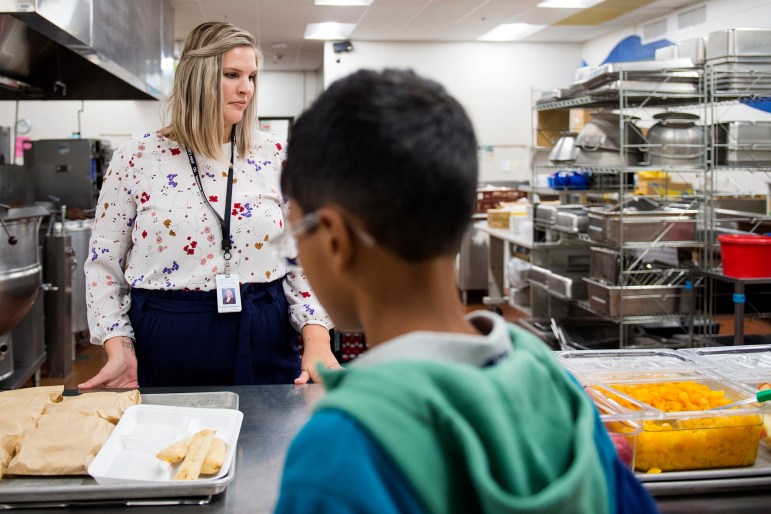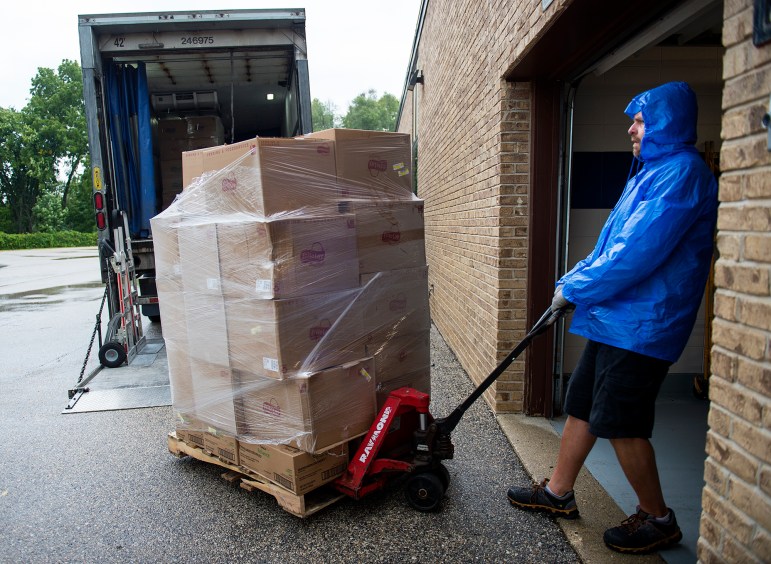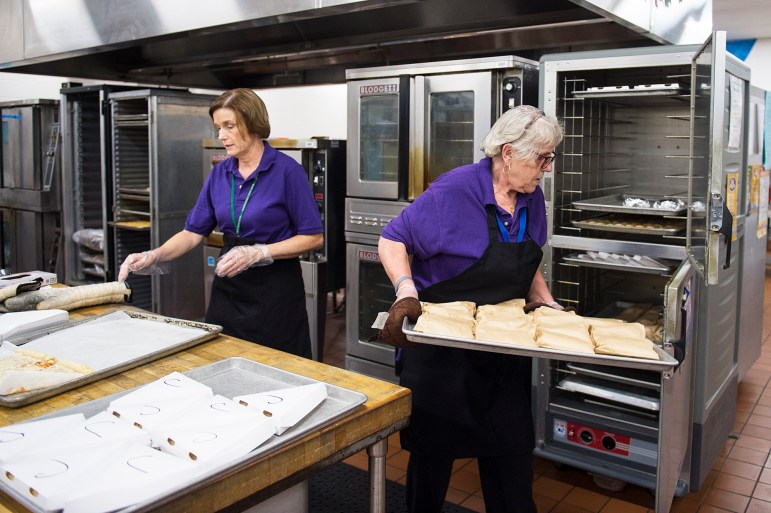KENOSHA — When Sadie Perez entered Indian Trail High School and Academy on a November morning, schoolwork was not on her mind. Instead, the then-junior was focused on an upcoming speech to the Kenosha School Board. She planned to bring a pressing concern to their next meeting — bad lunches.
Like the majority of schools in Wisconsin, the Kenosha Unified School District offered free meals to students during the 2021-22 academic year. But Perez and other students started to notice smaller portions, what appeared to be undercooked meat and fruit and vegetables covered with dark spots.

“The burgers that we had, the meat was really chewy and did not look cooked at all,” said Perez, who is now a senior. “Like they just threw it into a microwave and put two cold buns on it and hoped for the best.”
An Instagram account encouraged students to send in pictures of problematic food items, including gray patches on lunch meat and dirty vegetables, which were often posted with a #kusdfoodfails hashtag. A petition created by Indian Trail junior Katelyn Wilson garnered over 2,500 signatures.
“(For) a lot of people, this was their only source of food for the day,” Wilson said. “So we wanted to make sure that no matter what, people would be able to have access to healthier foods that they would actually be able to eat at school.”
Indian Trail High School students are not alone in their concerns. In the wake of supply chain and labor shortages that disrupted food service programs nationwide during the pandemic, news coverage of poor quality school meals exploded across Wisconsin and the country.
The disruptions shed light on the fragile procurement process behind school meals, prompting some Wisconsin school districts — and even the U.S. Department of Agriculture — to reconsider the streamlined national vendors that fuel school meals.
Wisconsin students and families felt the impact of the product shortages, too — leading students in Kenosha and Milwaukee to organize to question the quality and quantity of food ending up on their plates. And already this school year, parents and staff in Madison schools have raised the alarm about low quality, which officials blame on lack of supplies and people to prepare the meals.
A report by the School Nutrition Association released in July predicts that supply chain disruptions will persist through the 2022-23 school year, contributing to decreased student participation in school meals as standards that were relaxed during the pandemic remain in place.
“It has been very challenging and exhausting, and I don’t think we’re at the end yet,” said Caitlin Harrison, the president of the association’s Wisconsin chapter. “I think it might even get a little bit worse before it gets better.”
Supply chain snafus
In accordance with federal guidelines, school meals are made up of different food “components” — including lean proteins, whole grains, fruits, vegetables and dairy — based on the Dietary Guidelines for Americans. School meals also need to meet various specifications including calories, sodium and fat content.
For example, students in grades kindergarten through five should have an average of 550 to 650 calories for lunch, while high school students should get between 750 and 850 calories. At all grade levels, the amount of saturated fat is supposed to be less than 10% of total calories.
All the nutritional “checks and balances” that go into planning school meals can be difficult to juggle, especially for schools with fewer staff and resources, according to Harrison, who is also the food service director at the School District of Elmbrook in Brookfield.
The pandemic-era supply chain problems threw the already-complex procurement process out of whack as many schools across the nation relied on the same large vendors for their products. In the School Nutrition Association’s fall 2021 report, 99% of school meal directors surveyed cited product shortages as a challenge for their programs.

“I can tell you from experience, two or three days a week were spent on figuring out what we were going to get on the truck. And if we weren’t going to get what we wanted, we had to spend hours a day determining what we were going to serve students,” Harrison said.
Those challenges — coupled with labor shortfalls and other factors — have dramatically changed what students see on their plates.
To help ease the stress of product shortages, federal waivers have relaxed nutritional requirements for school meals and provided flexibility in what items they could serve. Additionally, Harrison noted an increase in the use of pre-packaged foods because of COVID-19 safety and logistical concerns, which also impacted the quality of food.
Free meals and curbside options during the pandemic meant more students and families were exposed to school meals — at a time when meal quality dipped.
‘Pink’ chicken, other problems
In Kenosha, Wilson and Perez noticed fewer students seemed to be eating the meals provided by the school as quality decreased. They also heard that the spicy chicken sandwiches, which appeared pink on the inside, gave students stomach aches.
“I just couldn’t bring myself to eat it (school lunch) because I was too scared of getting sick,” Wilson said.
A Kenosha Health Department inspection at Indian Trail High School found no food safety violations. Health Department spokesperson Lorma Wendt said the department did not get any official complaints or calls about students becoming sick from school meals.
Wendt noted that all chicken served at the school is already cooked when it arrives and is then heated up. But food quality is not a part of the department’s inspection criteria, so Wendt said the reports are “not going to address anything they (students) said.”
The district also monitored school lunches to “see firsthand what issues were experienced,” said Kenosha Unified School District spokesperson Tanya Ruder.
No complaints were brought forward, but Ruder acknowledged that supply chain shortages made it difficult to receive quality foods.
“Our food services staff works diligently each day to substitute items that are as close to the original menu items as possible to ensure our students and families feel little impact,” Ruder said in a statement.
After the students raised concerns, Perez noticed little change in the quality of food, so she started to bring lunch from home. She recognizes not all students share this privilege.
Said Perez: “School lunches are a saving grace for the kids whose parents are financially struggling and when you can’t deliver that, it’s not a saving grace anymore.”
School lunch ‘justice’
Concerns about school meal quality predated the pandemic.
According to a 2021 study, federal nutrition guidelines implemented under the 2010 Healthy Hunger-Free Kid Act helped make school meals among the healthiest meals children can eat. But healthy does not necessarily equate to high quality, fresh meals that students want to eat.
Even though over 50 million children have access to the National School Lunch program, only about 30 million students participated daily before the pandemic. Jennifer Gaddis, a national school food policy expert, said that’s partly due to a lack of historical investments in school nutrition programs to create appetizing, high quality meals.
“Over the years, it (school meals) has gotten worse and worse,” said Nevaeh Falcon Villanueva, a sophomore at Milwaukee’s Hamilton High School. “But then like COVID hit, and boom, it was bad.”
Falcon Villanueva is a part of Youth Empowered in the Struggle (YES), a group led by the immigrant advocacy organization Voces de la Frontera. After a YES survey of over 1,000 MPS students identified school meals as their top concern, the group launched the “School Lunch Justice” campaign in March. A petition for the campaign has garnered over 23,000 signatures.
“A lot of kids, they can’t focus because all they think about is, ‘Oh, my stomach’s hurting,’ ” said Doricela Herrera-Sanchez, a sophomore at Milwaukee School of Languages and a member of YES. “I know there’s some kids that have to forcefully eat (school lunch) because … they have nothing to eat.”

In a letter addressed to YES students and advisors, MPS School Nutrition Director Omer Abdullah pointed to the district’s efforts to provide fresh foods — including the Fresh Fruit and Vegetable Program, which offers healthy snacks and nutrition lessons at 55 elementary schools. The district also recently hired a chef to create new recipes and diversify menu offerings.
Abdullah said the pandemic further strained MPS’ food service program by worsening supply chain and labor problems. At the time of the letter in April, Abdullah said the district had 238 open positions in food service — a 27% vacancy rate.
Herrera-Sanchez and Falcon Villanueva called the response disappointing, especially regarding their request for more religion-accommodating options. Abdullah said schools are not required to provide accommodations for religious dietary restrictions and referenced federal nutritional guidelines as a barrier to providing more options for Muslim students — while acknowledging the current halal option of yogurt, string cheese and crackers appears to be “a series of snacks.”
Said Falcon Villanueva: “They (MPS) basically said, ‘We don’t have to, so we’re not going to.’ ”
Local food sourcing
Alongside challenges, the pandemic also provided opportunities for school food service programs.
Since all schools were eligible to provide free meals, more students could participate, and schools received a higher federal reimbursement rate per each meal sold. These extra funds allowed some schools to experiment with local food sourcing, Harrison said.

She said locally sourcing meals provides schools with more flexibility because they don’t have to rely on a lone large vendor. It also puts schools’ money directly back into the community. For example, a local food co-op Harrison worked with saw a $100,000 sales increase from schools during the pandemic.
Beyond logistical and economic benefits, Gaddis said school districts that develop farm-to-school supply chains and invest in scratch cooking tend to produce healthier, fresher meals and see increased participation among students and staff members. “That really matters a lot for the perception of school meals,” Gaddis said.
Said Harrison: “It’s (the pandemic) definitely created some more opportunity and creativity for us in school nutrition, looking outside of what the traditional process was and just finding different ways to be able to serve the students.”
The pandemic also prompted the federal government to invest more in local sourcing. The USDA provided $1.5 billion to help schools navigate supply chain issues — dedicating $200 million toward funding purchases from local food producers, of which Wisconsin received nearly $3.45 million.
Gaddis calls the USDA’s funding allocations and general language encouraging schools to invest locally a sign that it is rethinking the agency’s current approach to meals in terms of supply chain resilience and food quality.
Barriers persist
But Harrison cautions that USDA funding and temporarily boosted reimbursement rates are not long-term, sustainable investments in local food sourcing.

And other barriers remain, especially in Wisconsin. Those include a “seasonality mismatch” of available fruits and vegetables — with peak harvest times in the summer months when schools are closed — along with difficulties preserving and storing fresher ingredients, Gaddis said.
Scratch cooking also requires certain facilities and equipment that many Wisconsin schools lack, as well as more training for employees and higher food service labor costs.
Gaddis and Harrison agreed that state- or federal-level investment in infrastructure for local food sourcing and scratch cooking would be the most effective way to improve the quality of school meals.
In Wisconsin, 30 Democratic legislators are pushing for greater investment in school nutrition programs with the proposed Healthy School Meals for All Act. The legislation failed to make it out of committee earlier this year but continues to receive support from a statewide campaign.
The legislation’s main goal is to provide additional state reimbursements so all Wisconsin schools can provide universal free school meals. Co-author Rep. Kristina Shelton, D-Green Bay, said the higher reimbursements and increased participation could help pay for farm-to-school programs, scratch cooking equipment and higher wages for school food service workers.

“It’s all tied together. They’re different puzzle pieces of the same puzzle,” Shelton said. “We know that (free school meals) is not a magic bullet, it’s not a magic pill. It’s not going to solve every issue, but it is the most important step we can take.”
Some California districts have shown the initial investments can pay off. According to a 2020 study that looked at California schools with high and low levels of scratch cooking, schools spent similar percentages of their budgets on labor and food. Schools with higher scratch cooking spent more money on labor but less on food.
Subsidies can also incentivize scratch cooking, which Gaddis said states like Michigan, New York and California provide with additional state reimbursements.
“We’d have to keep in mind that we’ve spent so many decades building up this super industrialized national infrastructure,” Gaddis said. “We put a ton of public resources into building the current system.
Once we actually invest in these local and regional food systems, you might not necessarily have such a big cost differential.”
Reporter Maddie Bergstrom contributed to this report. The nonprofit Wisconsin Watch (www.WisconsinWatch.org) collaborates with WPR, PBS Wisconsin, other news media and the University of Wisconsin-Madison School of Journalism and Mass Communication. All works created, published, posted or disseminated by Wisconsin Watch do not necessarily reflect the views or opinions of UW-Madison or any of its affiliates.
This article first appeared on WisconsinWatch.org and is republished here under a Creative Commons license.


